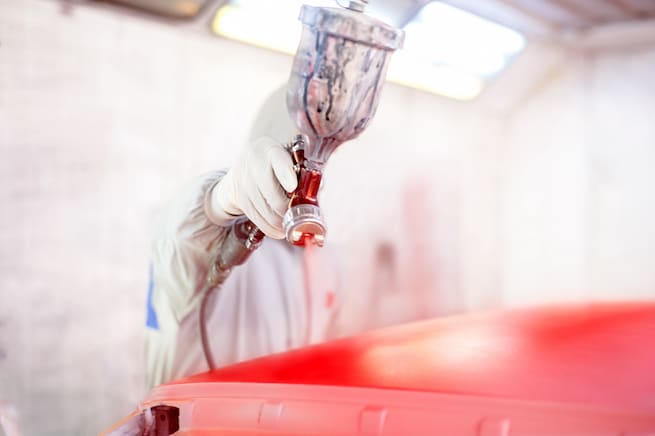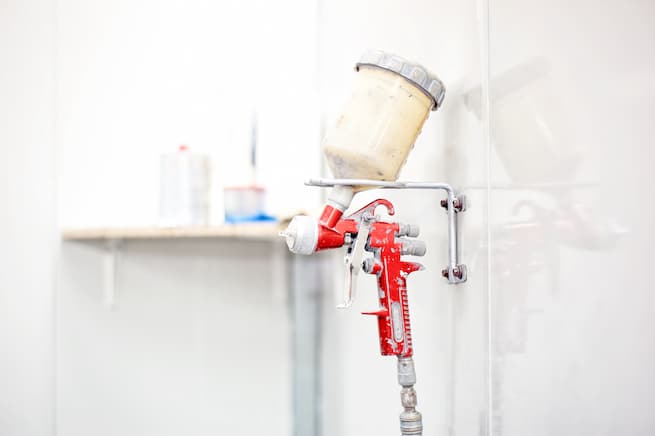Wagner Paint Sprayer Not Spraying [8 Fascinating Facts Why]
As a professional painter or someone who enjoys DIY projects, you understand the frustration of a Wagner paint sprayer not spraying properly. It can be a real nuisance, especially when you have a project deadline to meet.
Fortunately, there are several reasons why your paint sprayer may not be spraying correctly, and most of these issues are quick and easy to fix.
Whether you’re using an airless or HVLP paint sprayer, the frustration of a malfunctioning machine can be overwhelming. It’s important to understand that a paint gun is a machine that requires maintenance and cleaning to work effectively.
Neglecting these tasks can cause your paint spray gun to fail, leaving you with a botched paint job. In this blog post, we’ll provide some guidance on diagnosing and fixing the most common issues that can cause paint spray not to spray properly.
Issues Related to Paint Sprayers Not Spraying Properly

When a paint gun is not spraying as expected, it can be a significant drawback and hinder the painting process. Here are some common cons associated with a paint sprayer that is not spraying properly:
Inefficient Paint Application
A paint spray gun that fails to spray effectively can result in uneven or patchy paint coverage. This can lead to an unprofessional and inconsistent finish, requiring additional time and effort to correct.
Wasted Paint and Resources
If the paint gun is not functioning correctly, it may result in paint wastage. This can be frustrating and costly, as valuable paint is not being effectively utilized for the intended purpose.
Time-consuming Troubleshooting
Resolving the issue can be time-consuming. It often involves troubleshooting and identifying the root cause, which may require disassembling and cleaning the sprayer or replacing faulty components.
Delayed Project Completion
Dealing with a malfunctioning paint sprayer can lead to project delays. Time spent troubleshooting and resolving the issue prolongs the painting process, affecting timelines and potentially impacting other tasks or deadlines.
Frustration and Inconvenience
Using a Wagner paint sprayer that is not working correctly can be frustrating and inconvenient. It interrupts the painting workflow, hampers productivity, and may require additional time and effort to achieve the desired results.
Try not to use a long extension cord because it causes power drops.
Potential Additional Expenses
In some cases, addressing the problem may require purchasing replacement parts or seeking professional assistance. This can result in additional expenses beyond the initial investment in the sprayer itself.
It is important to address any issues with a Wagner paint sprayer not spraying promptly. Following the manufacturer’s maintenance, troubleshooting, and cleaning guidelines can help prevent such problems and ensure optimal performance.
Regular inspection, proper maintenance, and timely resolution of any spray-related issues are key to maximizing the benefits and efficiency of a paint sprayer.
Reasons Behind The Wagner Paint Sprayer Not Working Issue
When a Wagner paint sprayer is not spraying, it can be due to several potential issues. Here are some possible causes to consider:
Clogged Nozzle, Tip, or Suction Tube
One common reason for a paint sprayer that is not spraying is a clogged or blocked nozzle or tip. Paint residue or debris can accumulate over time and obstruct the flow of paint. Cleaning or replacing the nozzle, air filter, or tip can often resolve this issue.
Insufficient Paint Supply
If the paint container or reservoir is empty or has insufficient fluid, the sprayer may be unable to draw in enough paint to spray. This can also lead to the immersed suction tube. Ensure the paint container is adequately filled and properly connected to the sprayer.
Improper Paint Viscosity
Paint that is too thick or not properly thinned may not flow smoothly through the sprayer. Check the manufacturer’s recommendations for the correct viscosity of the paint and adjust it accordingly. Thinning the paint with the recommended solvent can help improve playability.
Faulty Pump or Motor
A malfunctioning pump or motor can prevent the proper flow of paint through the sprayer. If the pump is not generating sufficient pressure or the motor is not working correctly, it may need to be repaired or replaced.
Air Leakage or Insufficient Pressure
Air leaks in the Wagner paint sprayer or hose connections can disrupt the spray pattern and prevent proper air flow. Check all connections for any signs of leakage and clean or replace any damaged seals or fittings.
If the Wagner sprayer cannot maintain pressure
Inadequate Prime or Priming Procedure
Some paint sprayers, like airless paint sprayers, require a priming procedure to ensure proper pressure. Follow the manufacturer’s instructions for priming the sprayer correctly before use.
Electric Power or Air Supply Issues
If using an electric paint sprayer, ensure that it is properly connected to a power source and that the power supply works. If using an air-powered sprayer, check the air compressor for adequate pressure and proper operation.
Equipment Maintenance
Regular maintenance is essential for the smooth operation of a sprayer. Check for any worn-out or damaged parts, such as seals, gaskets, or filters, and replace them as needed.
By considering these possible issues and troubleshooting steps, you can identify the cause of your sprayer not functioning and take the necessary actions to resolve the problem. If the issue persists, consulting the manufacturer’s guidelines or contacting their customer support may provide further assistance.
What Can You Do If Your Paint Sprayers Are Not Spraying?

High-efficiency airless paint sprayers draw paint directly from the paint container, and the paint passes with high pressure thru the hose until it reaches the Wagner sprayer. This will prevent you from spraying too much paint and not waste a lot of oil-based materials.
The best thing you can do is to ensure the sprayer is properly cleaned. Use a cleaning solution with hot water to remove old droplets or material that is stuck on the HVLP gun. Here are several other steps you can take to troubleshoot and address the issue:
Check Paint Supply and Viscosity
Ensure that the paint container or reservoir is filled with sufficient paint. If the paint level is too low, the sprayer may be unable to draw in the paint properly. Refill or replace the container as needed.
Check if the paint being used is properly thinned or has the correct viscosity for the airless paint sprayer. Paint that is too thick can clog the sprayer, while too thin paint may result in excessive overspray. Follow the manufacturer’s recommendations for the correct paint viscosity and adjust if necessary.
Clean the Spray Tip Orifice
Cleaning the spray tip of a paint sprayer offers several benefits that contribute to the overall performance and efficiency of the equipment. Here are some key advantages:
Over time, paint residues, debris, or dried paint particles can accumulate in the tip of the airless sprayer, leading to clogs. Regular cleaning helps remove these obstructions, ensuring uninterrupted paint flow and preventing costly and time-consuming delays during painting jobs.
A clean tip facilitates a smooth and consistent finish. By removing any blockages or build-up, the paint sprayer can deliver a steady supply of fluid, enabling even coverage and reducing the likelihood of sputtering or inconsistent spray patterns.
Improves Spray Patterns
Clogged tips can result in an uneven or distorted spray pattern, leading to an undesirable finish. Cleaning the tip ensures the orifices are clear and unobstructed, allowing for a precise and consistent pattern.
This is particularly important when aiming for a professional and uniform appearance. The spray tip’s cleanliness directly affects the paint particles’ atomization. A clean tip ensures that the residual paint is properly atomized into fine particles, improving the quality and smoothness of the sprayed finish.
This finer atomization also contributes to better paint adhesion and reduced overspray. Regular cleaning of the suction tube and spray tip helps maintain the overall condition of the paint sprayer.
Cleaning the tip is a relatively simple and quick task that can save valuable time during painting projects. Ensuring optimal spray patterns reduces the need for rework or touch-ups caused by uneven or unsatisfactory results.
Regularly cleaning the tip and suction tube also helps prevent costly repairs or replacements that may arise from neglecting maintenance. Any service center can help you repair your damaged unit in case you are having issues with your old paint sprayer.
Inspect the Spray Gun Components
Examine the spray gun for any damaged or worn-out parts that may be affecting its functionality. Check the spray gun filter, air valve tube, nozzle, suction hose, tip, needle, inlet screen, outlet spraying valve, and seals for any signs of wear or defects. Replace any faulty components as necessary.
The suction air tube is loose at the inlet valve/suction valve or end of the fluid pump. A loose suction tube can significantly impact the functionality of a Wagner sprayer, so ensure to check it out.
Ensure that the air compressor or pump providing the air pressure to the sprayer is functioning properly. Check for an air leak or blockage in the air hoses, and make sure the pressure is set to the recommended level for your specific sprayer model.
Test Different Spray Patterns and Adjustments
Experiment with different spray patterns and adjustments to see if there is any improvement. Adjust the nozzle or paint flow settings to achieve the desired effect. Sometimes, a simple adjustment can resolve the issue.
If you cannot achieve maximum pressure, it is likely that you have a worn tip or damaged piston rod. The piston packings on the back of the pump need to be tightened properly. Different coatings will require a specific tip so that you can cover the surface you are painting with precision.
Check Bypass Knob Position
Ensure that the pressure control knob is in the correct position before pressing the gun trigger. The bypass knob is typically used to control the pressure or flow of the sprayer. Make sure it is not in the “bypass” or “off” position, as this would prevent the spray paint from being sprayed. Adjust the knob to the appropriate setting for normal HVLP system operation.
If the above steps do not resolve the problem, consult the sprayer’s user manual or contact the manufacturer’s customer support for further assistance. They can provide specific troubleshooting advice based on the make and model of the sprayer.
Last Troubleshooting Tips For A Wagner Sprayer
Several potential causes can contribute to this problem, including clogged nozzles or tips, low air pressure, faulty spray gun components, air leakage, or incorrect sprayer setup. To resolve the issue, it is important to troubleshoot and address each possible cause systematically.
This may involve cleaning or unclogging the nozzle or tip, ensuring an adequate fluid supply, adjusting the paint viscosity to the manufacturer’s recommendations, increasing the air pressure, inspecting and replacing any faulty sprayer parts, sealing any paint leaks, or ensuring proper sprayer setup and configuration. The old material needs to be removed from your HVLP system.
Last Updated on: March 16, 2025

